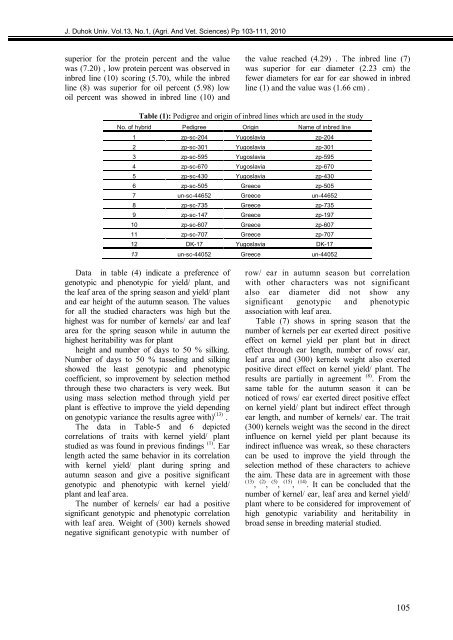The Influence Of Priming Two Cucumber Cultivar Seeds
The Influence Of Priming Two Cucumber Cultivar Seeds
The Influence Of Priming Two Cucumber Cultivar Seeds
You also want an ePaper? Increase the reach of your titles
YUMPU automatically turns print PDFs into web optimized ePapers that Google loves.
J. Duhok Univ. Vol.13, No.1, (Agri. And Vet. Sciences) Pp 103-111, 2010<br />
superior for the protein percent and the value<br />
was (7.20) , low protein percent was observed in<br />
inbred line (10) scoring (5.70), while the inbred<br />
line (8) was superior for oil percent (5.98) low<br />
oil percent was showed in inbred line (10) and<br />
the value reached (4.29) . <strong>The</strong> inbred line (7)<br />
was superior for ear diameter (2.23 cm) the<br />
fewer diameters for ear for ear showed in inbred<br />
line (1) and the value was (1.66 cm) .<br />
Table (1): Pedigree and origin of inbred lines which are used in the study<br />
No. of hybrid Pedigree Origin Name of inbred line<br />
1 zp-sc-204 Yugoslavia zp-204<br />
2 zp-sc-301 Yugoslavia zp-301<br />
3 zp-sc-595 Yugoslavia zp-595<br />
4 zp-sc-670 Yugoslavia zp-670<br />
5 zp-sc-430 Yugoslavia zp-430<br />
6 zp-sc-505 Greece zp-505<br />
7 un-sc-44652 Greece un-44652<br />
8 zp-sc-735 Greece zp-735<br />
9 zp-sc-147 Greece zp-197<br />
10 zp-sc-607 Greece zp-607<br />
11 zp-sc-707 Greece zp-707<br />
12 DK-17 Yugoslavia DK-17<br />
13 un-sc-44052 Greece un-44052<br />
Data in table (4) indicate a preference of<br />
genotypic and phenotypic for yield/ plant, and<br />
the leaf area of the spring season and yield/ plant<br />
and ear height of the autumn season. <strong>The</strong> values<br />
for all the studied characters was high but the<br />
highest was for number of kernels/ ear and leaf<br />
area for the spring season while in autumn the<br />
highest heritability was for plant<br />
height and number of days to 50 % silking.<br />
Number of days to 50 % tasseling and silking<br />
showed the least genotypic and phenotypic<br />
coefficient, so improvement by selection method<br />
through these two characters is very week. But<br />
using mass selection method through yield per<br />
plant is effective to improve the yield depending<br />
on genotypic variance the results agree with) (13) .<br />
<strong>The</strong> data in Table-5 and 6 depicted<br />
correlations of traits with kernel yield/ plant<br />
studied as was found in previous findings (1) . Ear<br />
length acted the same behavior in its correlation<br />
with kernel yield/ plant during spring and<br />
autumn season and give a positive significant<br />
genotypic and phenotypic with kernel yield/<br />
plant and leaf area.<br />
<strong>The</strong> number of kernels/ ear had a positive<br />
significant genotypic and phenotypic correlation<br />
with leaf area. Weight of (300) kernels showed<br />
negative significant genotypic with number of<br />
row/ ear in autumn season but correlation<br />
with other characters was not significant<br />
also ear diameter did not show any<br />
significant genotypic and phenotypic<br />
association with leaf area.<br />
Table (7) shows in spring season that the<br />
number of kernels per ear exerted direct positive<br />
effect on kernel yield per plant but in direct<br />
effect through ear length, number of rows/ ear,<br />
leaf area and (300) kernels weight also exerted<br />
positive direct effect on kernel yield/ plant. <strong>The</strong><br />
results are partially in agreement (8) . From the<br />
same table for the autumn season it can be<br />
noticed of rows/ ear exerted direct positive effect<br />
on kernel yield/ plant but indirect effect through<br />
ear length, and number of kernels/ ear. <strong>The</strong> trait<br />
(300) kernels weight was the second in the direct<br />
influence on kernel yield per plant because its<br />
indirect influence was wreak, so these characters<br />
can be used to improve the yield through the<br />
selection method of these characters to achieve<br />
the aim. <strong>The</strong>se data are in agreement with those<br />
(13) , (2) , (5) , (15) , (14) . It can be concluded that the<br />
number of kernel/ ear, leaf area and kernel yield/<br />
plant where to be considered for improvement of<br />
high genotypic variability and heritability in<br />
broad sense in breeding material studied.<br />
301



